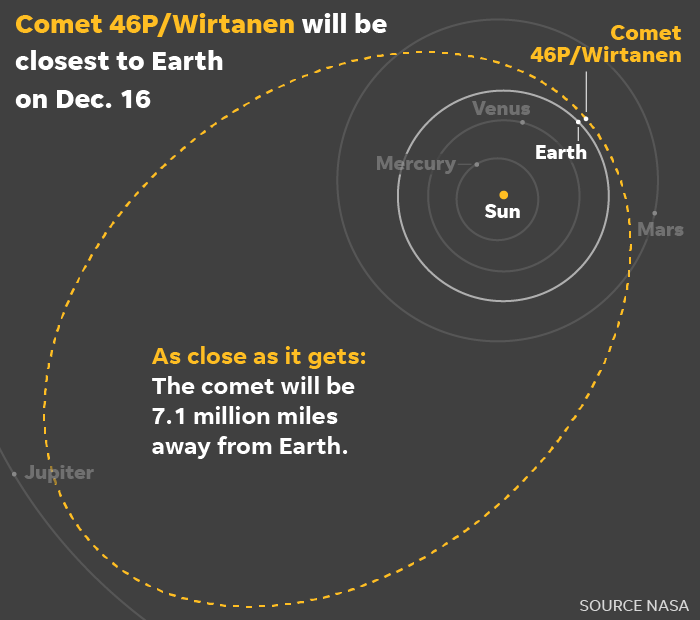Comet named after Kenosha astronomer zipping close to Earth this week
A comet named after the Kenosha astronomer who first glimpsed it will streak past Earth this week.
Comet 46P/Wirtanen is the brightest comet seen this year for inhabitants of the third planet from the sun — that would be Earth — though don't expect it to look like someone flung a handful of sparkly glitter into the sky.

Since Comet 46P/Wirtanen is fairly weak, it will look like a diffused blob of glowing gray light. But on the plus side, it can be seen with binoculars in a fairly easy to find location in the heavens as long as stargazers are willing to get out of cities and find dark skies. Actually, binoculars aren't needed, though they will make it easier to see.
It will be one of the closest comet flybys to Earth since the 1950s and the 20th-closest approach of a comet dating back to the 9th century A.D., according to space.com.
"Even though technically a naked-eye comet doesn't have to be very bright, they're still relatively unusual," said Jim Lattis, director of University of Wisconsin Space Place, UW-Madison's astronomy outreach center.

Named after Carl Wirtanen, the comet orbits the sun every five and a half years — a blink of an eye in astronomical terms. Since Comet 46P/Wirtanen is not particularly bright, its approaches to Earth are not usually impressive. But this year's flyby will be among its best.
The optimum time to see Comet 46P/Wirtanen will be Monday when it scoots closest to the Earth at just a bit over 7 million miles. That's about 30 times farther away than the moon.
"Another reason it's getting so much attention, it's well-placed for us," Lattis said. "You can see it high overhead in the early evening hours in the Northern Hemisphere. That's stimulating a lot of people to get out and see it."
Wirtanen was born in Kenosha in 1910 and caught the astronomy bug at the age of 12 when his violin teacher took him to a local observatory, according to his 1990 American Astronomical Society obituary. That might have been the observatory at Carthage College in Kenosha or possibly Yerkes Observatory in Williams Bay.
After majoring in astronomy, math and physics at the University of Virginia, Wirtanen went to work at the Lick Observatory in California. Soon after he was hired at the Lick Observatory, Wirtanen took four years off to participate in ballistics research at the Naval Ordnance Test Station in California during World War II.
Wirtanen was a well-regarded astronomical object hunter and surveyor of the Milky Way. He discovered five comets and three asteroids, including an asteroid known as (29075) 1950 DA, which could strike Earth in 862 years.
He discovered the comet that was named after him in 1948 while using photos to survey the movement of faint, distant stars.
When Comet 46P/Wirtanen makes its closest pass by the sun on Wednesday, some of the ice and frozen carbon dioxide (dry ice) and carbon monoxide will vaporize in the solar heat and turn into a gas, forming a vast cloud around the comet. That's what folks on terra firma will see.
Comets are basically the dust pans of the solar system — leftover debris from the formation of the solar system. They consist of boulders, rocks, dust and ice, essentially dirty snowballs. The reason why they're icier than other debris is because they started farther away from the sun, explained Bob Bonadurer, director of the Milwaukee Public Museum's Daniel M. Soref National Geographic Dome Theater & Planetarium.
Bonadurer is pointing out Comet 46P/Wirtanen to planetarium visitors this week to encourage people to see it.
"It will be very diffused, a spread-out graying glow," said Bonadurer. "Like someone spray-painted a gray blob on the sky. You'll see green colors, which is mostly caused by carbon, only if you're taking photos or you've got a pretty good telescope."
To catch a glimpse of Comet Wirtanen, look toward the constellation Taurus, just west of Orion, which can be quickly found through the three stars of Orion's belt. Comet Wirtanen will lie between two bright star clusters, the Pleiades and the Hyades.
"It's right by two very recognizable objects. It will be fairly easy to star hop — find something familiar and then hop over," Bonadurer said. "That's wonderful."
RELATED:Yerkes Observatory closing, but workers trying to preserve educational programs
Another reason to head outside and stare skyward is because the Geminid meteor showers will be at their peak this weekend. The Geminids are usually the best meteor showers of the year but because they happen in December when it's cold, not as many people want to stand outside and watch, said Bonadurer. NASA is forecasting as many as 100 meteors per hour.
The Geminids peak on Friday, though Thursday and Saturday will be a good period to see them, depending on the weather.
The National Weather Service forecast for southeastern Wisconsin calls for partly cloudy skies Thursday through Sunday with a chance for rain and snow Thursday and Friday nights.